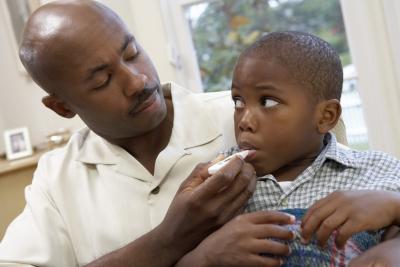Fevers are common in toddlers and occur for a variety of reasons. While fevers can be scary, they are usually not a serious threat to your child. Knowing when the fever indicates a more severe illness is key to getting your toddler healthy again. The other symptoms that accompany the fever are particularly critical in determining the need for medical attention.
Diagnosing
The normal body temperature is 98.6 F, but some children vary between 97 and 100 F, according to BabyCenter. If your child’s forehead feels warm to the touch, a thermometer can help you confirm a fever. You can take temperature with three different types of thermometers — rectal, mouth and ear. Make sure the thermometer you use is appropriate for the type of temperature you want to take. Ear thermometers aren’t as accurate for fevers over 102 F.
Causes
Fevers usually appear to fight off an infection in the body. Several possible infections could cause a fever. Most causes aren’t severe, but some can be life-threatening, including bacterial meningitis. Viruses are the common cause of toddler fevers, but bacterial infections can also cause high fevers. The other symptoms that accompany the fever are more indicative of the specific cause.
Treatment
The fever itself doesn’t cause brain damage until it reaches 107 F, according to the Palo Alto Medical Foundation. Treating the fever is more for the comfort of your child than for his safety unless the temperature continues climbing to dangerous levels. Acetaminophen and ibuprofen are the two medications typically used to lower fever in toddlers. Choose the children’s version and follow dosing directions exactly to avoid serious side effects. Aspirin is not recommended for toddlers due to the risk of Reye’s syndrome. Limiting the clothing your child wears can prevent the fever from increasing. A lukewarm sponge bath is also an option. Don’t use rubbing alcohol, which can make your child too cold too fast.
Febrile Seizures
Febrile seizures occur in some toddlers with a high fever, especially if the child’s temperature is increasing quickly. Symptoms of a febrile seizure vary, but they may include jerking movements, twitching, rolling eyes, vomiting, drooling or limb stiffness. While scary to parents, febrile seizures aren’t generally harmful to toddlers. Your child’s doctor should evaluate him after a febrile seizure as a precaution.
Medical Attention
If your child’s fever reaches 103 F, a call to the doctor is a good idea. The doctor may want to see your child in the office based on the other symptoms. If your child is playing, eating and acting normally, she might be fine without medical attention. A child who acts sick should see a doctor to determine the cause. Neck stiffness, neck pain and headache are other symptoms that need immediate medical attention because they could mean meningitis. Breathing difficulty along with the fever is another cause for a trip to the doctor. When in doubt, give your doctor’s office or an ask-a-nurse line a call to determine if your child needs medical attention.





